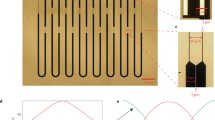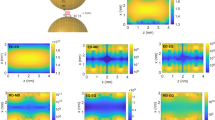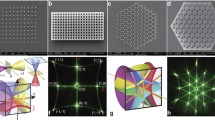Abstract
Effective-medium theory pertains to the theoretical modelling of homogenization, which aims to replace an inhomogeneous structure of subwavelength-scale constituents with a homogeneous effective medium. The effective-medium theory is fundamental to various realms, including electromagnetics and material science, since it can largely decrease the complexity in the exploration of light-matter interactions by providing simple acceptable approximation. Generally, the effective-medium theory is thought to be applicable to any all-dielectric system with deep-subwavelength constituents, under the condition that the effective medium does not have a critical angle, at which the total internal reflection occurs. Here we reveal a fundamental breakdown of the effective-medium theory that can be applied in very general conditions: showing it for deep-subwavelength all-dielectric multilayers even without a critical angle. Our finding relies on an exotic photonic spin Hall effect, which is shown to be ultrasensitive to the stacking order of deep-subwavelength dielectric layers, since the spin-orbit interaction of light is dependent on slight phase accumulations during the wave propagation. Our results indicate that the photonic spin Hall effect could provide a promising and powerful tool for measuring structural defects for all-dielectric systems even in the extreme nanometer scale.
Similar content being viewed by others
References
T. Koschny, M. Kafesaki, E. N. Economou, and C. M. Soukoulis, Phys. Rev. Lett. 93, 107402 (2004), arXiv: cond-mat/0407366.
F. Lemoult, N. Kaina, M. Fink, and G. Lerosey, Nat. Phys. 9, 55 (2013).
T. C. Choy, Effective Medium Theory: Principles and Applications (2nd ed.) (Oxford University Press, Oxford, 2015).
J. A. Kong, Electromagnetic Wave Theory (EMW Publishing, Cambridge, 2008).
A. Vakil, and N. Engheta, Science 332, 1291 (2011).
D. N. Basov, M. M. Fogler, and F. J. Garcia de Abajo, Science 354, aag1992 (2016).
T. Low, A. Chaves, J. D. Caldwell, A. Kumar, N. X. Fang, P. Avouris, T. F. Heinz, F. Guinea, L. Martin-Moreno, and F. Koppens, Nat. Mater. 16, 182 (2017), arXiv: 1610.04548.
X. Lin, Z. Liu, T. Stauber, G. Gómez-Santos, F. Gao, H. Chen, B. Zhang, and T. Low, Phys. Rev. Lett. 125, 077401 (2020), arXiv: 2006.10474.
J. C. M. Garnett, Phil. Trans. R. Soc. Lond. A 203, 385 (1904).
N. I. Landy, S. Sajuyigbe, J. J. Mock, D. R. Smith, and W. J. Padilla, Phys. Rev. Lett. 100, 207402 (2008), arXiv: 0803.1670.
W. Cai, and V. M. Shalaev, Optical Metamaterials (Springer, New York, 2010).
Y. Liu, and X. Zhang, Chem. Soc. Rev. 40, 2494 (2011).
N. I. Zheludev, and Y. S. Kivshar, Nat. Mater. 11, 917 (2012).
S. Sun, Q. He, S. Xiao, Q. Xu, X. Li, and L. Zhou, Nat. Mater. 11, 426 (2012).
A. V. Kildishev, A. Boltasseva, and V. M. Shalaev, Science 339, 1232009 (2013).
X. Yin, Z. Ye, J. Rho, Y. Wang, and X. Zhang, Science 339, 1405 (2013).
H. T. Chen, A. J. Taylor, and N. Yu, Rep. Prog. Phys. 79, 076401 (2016), arXiv: 1605.07672.
D. R. Smith, and N. Kroll, Phys. Rev. Lett. 85, 2933 (2000).
R. A. Shelby, D. R. Smith, and S. Schultz, Science 292, 77 (2001).
V. M. Shalaev, Nat. Photon. 1, 41 (2007).
J. Valentine, S. Zhang, T. Zentgraf, E. Ulin-Avila, D. A. Genov, G. Bartal, and X. Zhang, Nature 455, 376 (2008).
A. Poddubny, I. Iorsh, P. Belov, and Y. Kivshar, Nat. Photon. 7, 948 (2013).
L. Shen, X. Lin, M. Y. Shalaginov, T. Low, X. Zhang, B. Zhang, and H. Chen, Appl. Phys. Rev. 7, 021403 (2020), arXiv: 2003.12727.
D. Lee, S. So, G. Hu, M. Kim, T. Badloe, H. Cho, J. Kim, H. Kim, C. W. Qiu, and J. Rho, eLight 2, 1 (2022).
J. Valentine, J. Li, T. Zentgraf, G. Bartal, and X. Zhang, Nat. Mater. 8, 568 (2009), arXiv: 0904.3602.
T. Cai, B. Zheng, J. Lou, L. Shen, Y. Yang, S. Tang, E. Li, C. Qian, and H. Chen, Adv. Mater. 34, 2205053 (2022).
J. B. Pendry, Phys. Rev. Lett. 85, 3966 (2000).
N. Fang, H. Lee, C. Sun, and X. Zhang, Science 308, 534 (2005).
I. I. Smolyaninov, Y. J. Hung, and C. C. Davis, Science 315, 1699 (2007), arXiv: physics/0610230.
X. Zhang, and Z. Liu, Nat. Mater. 7, 435 (2008).
F. Wang, and Y. R. Shen, Phys. Rev. Lett. 97, 206806 (2006).
O. Kidwai, S. V. Zhukovsky, and J. E. Sipe, Phys. Rev. A 85, 053842 (2012).
M. Mahmoodi, S. H. Tavassoli, O. Takayama, J. Sukham, R. Malureanu, and A. V. Lavrinenko, Laser Photonics Rev. 13, 1800253 (2019).
H. Hu, X. Lin, J. Zhang, D. Liu, P. Genevet, B. Zhang, and Y. Luo, Laser Photonics Rev. 14, 2000149 (2020).
H. H. Sheinfux, I. Kaminer, Y. Plotnik, G. Bartal, and M. Segev, Phys. Rev. Lett. 113, 243901 (2014).
S. V. Zhukovsky, A. Andryieuski, O. Takayama, E. Shkondin, R. Malureanu, F. Jensen, and A. V. Lavrinenko, Phys. Rev. Lett. 115, 177402 (2015), arXiv: 1506.08078.
A. Andryieuski, A. V. Lavrinenko, and S. V. Zhukovsky, Nanotechnology 26, 184001 (2015).
H. H. Sheinfux, I. Kaminer, A. Z. Genack, and M. Segev, Nat. Commun. 7, 12927 (2016).
H. H. Sheinfux, Y. Lumer, G. Ankonina, A. Z. Genack, G. Bartal, and M. Segev, Science 356, 953 (2017).
M. Onoda, S. Murakami, and N. Nagaosa, Phys. Rev. Lett. 93, 083901 (2004), arXiv: cond-mat/0405129.
K. Y. Bliokh, and Y. P. Bliokh, Phys. Rev. Lett. 96, 073903 (2006), arXiv: physics/0508093.
O. Hosten, and P. Kwiat, Science 319, 787 (2008).
K. Y. Bliokh, A. Niv, V. Kleiner, and E. Hasman, Nat. Photon. 2, 748 (2008), arXiv: 0810.2136.
Y. Qin, Y. Li, H. He, and Q. Gong, Opt. Lett. 34, 2551 (2009).
X. Ling, X. Zhou, K. Huang, Y. Liu, C. W. Qiu, H. Luo, and S. Wen, Rep. Prog. Phys. 80, 066401 (2017).
B. Wang, K. Rong, E. Maguid, V. Kleiner, and E. Hasman, Nat. Nanotechnol. 15, 450 (2020).
M. Kim, D. Lee, and J. Rho, Laser Photonics Rev. 15, 2100138 (2021), arXiv: 2101.08938.
C. Chi, Q. Jiang, Z. Liu, L. Zheng, M. Jiang, H. Zhang, F. Lin, B. Shen, and Z. Fang, Sci. Adv. 7, eabf8011 (2021).
L. Sheng, X. Zhou, Y. Zhong, X. Zhang, Y. Chen, Z. Zhang, H. Chen, and X. Lin, Laser Photonics Rev. 17, 2200534 (2023).
Z. Chen, Y. Chen, Y. Wu, X. Zhou, H. Sun, T. Low, H. Chen, and X. Lin, Phys. Rev. B 106, 075409 (2022), arXiv: 2202.10732.
J. Petersen, J. Volz, and A. Rauschenbeutel, Science 346, 67 (2014), arXiv: 1406.2184.
K. Y. Bliokh, F. J. Rodríguez-Fortuno, F. Nori, and A. V. Zayats, Nat. Photon. 9, 796 (2015).
F. Cardano, and L. Marrucci, Nat. Photon. 9, 776 (2015).
Z. Shao, J. Zhu, Y. Chen, Y. Zhang, and S. Yu, Nat. Commun. 9, 926 (2018), arXiv: 1709.09811.
S. Fu, C. Guo, G. Liu, Y. Li, H. Yin, Z. Li, and Z. Chen, Phys. Rev. Lett. 123, 243904 (2019).
L. Fang, H. Wang, Y. Liang, H. Cao, and J. Wang, Phys. Rev. Lett. 127, 233901 (2021).
H. Luo, X. Ling, X. Zhou, W. Shu, S. Wen, and D. Fan, Phys. Rev. A 84, 033801 (2011), arXiv: 1105.2936.
B. Wang, Y. Li, M. M. Pan, J. L. Ren, Y. F. Xiao, H. Yang, and Q. Gong, Phys. Rev. A 88, 043842 (2013).
H. Dai, L. Yuan, C. Yin, Z. Cao, and X. Chen, Phys. Rev. Lett. 124, 053902 (2020).
M. Neugebauer, S. Nechayev, M. Vorndran, G. Leuchs, and P. Banzer, Nano Lett. 19, 422 (2019).
Author information
Authors and Affiliations
Corresponding authors
Ethics declarations
Conflict of interest The authors declare that they have no conflict of interest.
Additional information
Xiao Lin acknowledges the support partly from the National Natural Science Fund for Excellent Young Scientists Fund Program (Overseas) of China, National Natural Science Foundation of China (Grant No. 62175212), Zhejiang Provincial Natural Science Fund Key Project (Grant No. Z23F050009), Fundamental Research Funds for the Central Universities (Grant No. 2021FZZX001-19), and Zhejiang University Global Partnership Fund. Hongsheng Chen acknowledges the support partly from the Key Research and Development Program of the Ministry of Science and Technology (Grant Nos. 2022YFA1404704, 2022YFA1404902, and 2022YFA1405200), and the National Natural Science Foundation of China (Grant Nos. 11961141010, and 61975176). Ido Kaminer acknowledges the support from the Israel Science Foundation (Grant No. 3334/19), and the Israel Science Foundation (Grant No. 830/19). Xinxing Zhou was supported by the National Natural Science Foundation of China (Grant No. 11604095), and the Training Program for Excellent Young Innovators of Changsha (Grant No. kq2107013).
Supporting Information
The supporting information is available online at http://phys.scichina.com and https://link.springer.com. The supporting materials are published as submitted, without typesetting or editing. The responsibility for scientific accuracy and content remains entirely with the authors.
Electronic supplementary material
Rights and permissions
About this article
Cite this article
Yuan, S., Zhou, X., Chen, Y. et al. Breakdown of effective-medium theory by a photonic spin Hall effect. Sci. China Phys. Mech. Astron. 66, 114212 (2023). https://doi.org/10.1007/s11433-023-2177-3
Received:
Accepted:
Published:
DOI: https://doi.org/10.1007/s11433-023-2177-3




